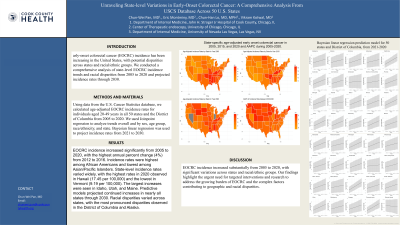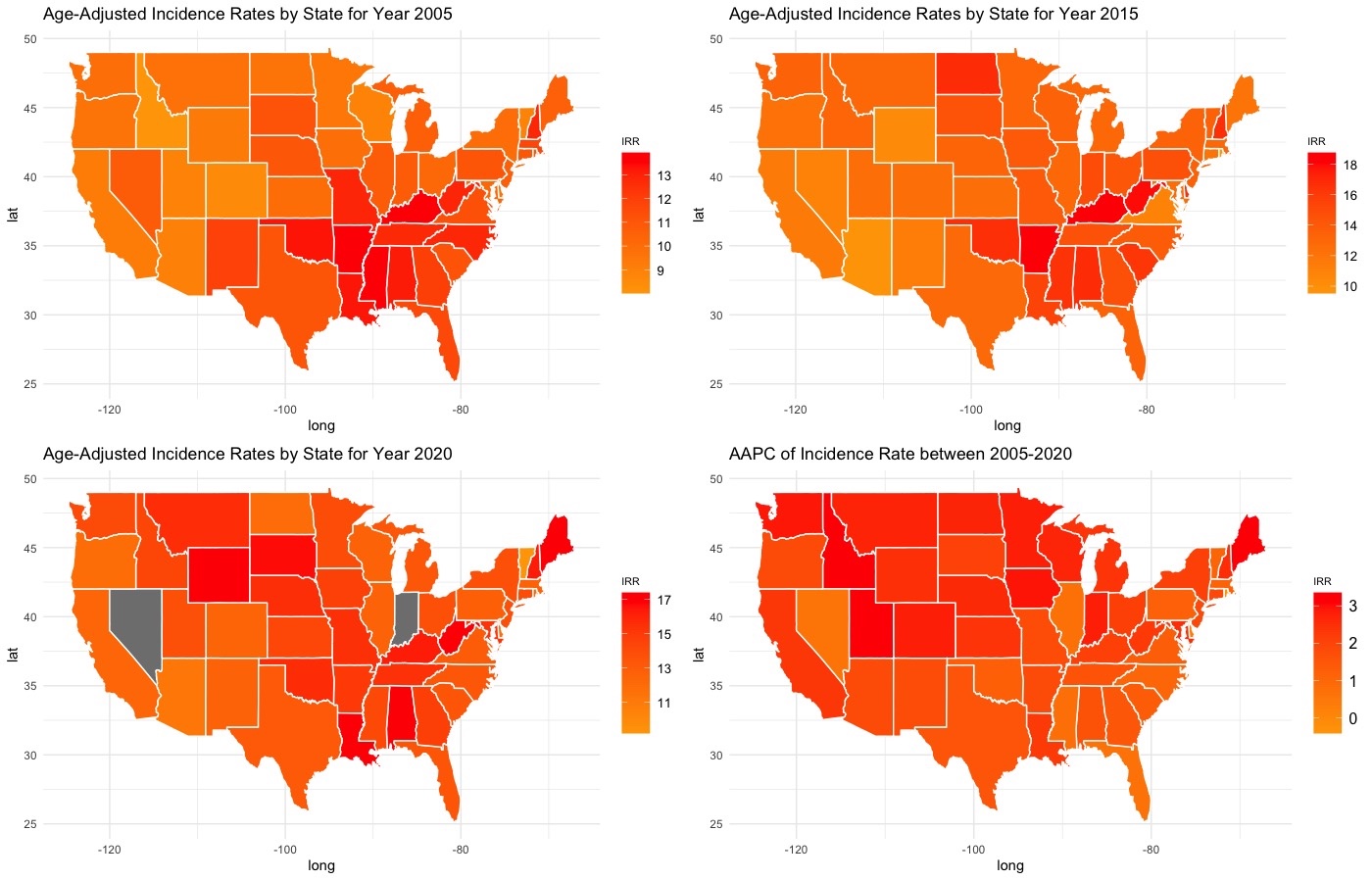Monday Poster Session
Category: Colorectal Cancer Prevention
P2159 - Unraveling State-level Variations in Early-Onset Colorectal Cancer: A Comprehensive Analysis From USCS Database Across 50 U.S. States
Monday, October 28, 2024
10:30 AM - 4:00 PM ET
Location: Exhibit Hall E

Has Audio

Chun-Wei Pan, MD
John H. Stroger, Jr. Hospital of Cook County
Chicago, IL
Presenting Author(s)
Chun-Wei Pan, MD1, Eric Montminy, MD2, Chun-Han Lo, MD, MPH3, Vikram Kotwal, MD1
1John H. Stroger, Jr. Hospital of Cook County, Chicago, IL; 2Center for Endoscopic Research and Therapeutics (CERT), University of Chicago, Chicago, IL; 3Kirk Kerkorian School of Medicine at the University of Nevada, Las Vegas, NV
Introduction: Early-onset colorectal cancer (EOCRC) incidence has been increasing in the United States, with potential disparities across states and racial/ethnic groups. We conducted a comprehensive analysis of state-level EOCRC incidence trends and racial disparities from 2005 to 2020 and projected incidence rates through 2030.
Methods: Using data from the U.S. Cancer Statistics database, we calculated age-adjusted EOCRC incidence rates for individuals aged 20-49 years in all 50 states and the District of Columbia from 2005 to 2020. We used Joinpoint regression to analyze trends overall and by sex, age group, race/ethnicity, and state. Bayesian linear regression was used to project incidence rates from 2021 to 2030.
Results: EOCRC incidence increased significantly from 2005 to 2020, with an overall incidence rate of 13.6 per 100,000 person-years in 2020 and the highest annual percent change (4%) from 2012 to 2016. African Americans had the highest incidence rates (13.8 per 100,000), while Asian/Pacific Islanders had the lowest (9.9 per 100,000). While White population had the highest increase in AAPC (1.8%) between 2005 and 2020. In 2020, state-level incidence rates ranged from 17.45 per 100,000 in Hawaii to 9.19 per 100,000 in Vermont. Idaho, Utah, and Maine experienced the largest increases, with AAPCs of 3.35%, 3.28%, and 3.1%, respectively. Racial disparities varied across states, with incidence rate ratios (IRRs) relative to Whites ranging from 1.53 for African Americans in the District of Columbia to 0.33 for American Indian/Alaska Natives in Florida. Predictive models projected incidence rates exceeding 20 per 100,000 by 2030 in Idaho and Utah, while Hawaii and Vermont are expected to have more stable trends.
Discussion: EOCRC incidence increased substantially from 2005 to 2020, with significant variations across states and racial/ethnic groups. Our findings highlight the urgent need for targeted interventions and research to address the growing burden of EOCRC and the complex factors contributing to geographic and racial disparities.

Note: The table for this abstract can be viewed in the ePoster Gallery section of the ACG 2024 ePoster Site or in The American Journal of Gastroenterology's abstract supplement issue, both of which will be available starting October 27, 2024.
Disclosures:
Chun-Wei Pan, MD1, Eric Montminy, MD2, Chun-Han Lo, MD, MPH3, Vikram Kotwal, MD1. P2159 - Unraveling State-level Variations in Early-Onset Colorectal Cancer: A Comprehensive Analysis From USCS Database Across 50 U.S. States, ACG 2024 Annual Scientific Meeting Abstracts. Philadelphia, PA: American College of Gastroenterology.
1John H. Stroger, Jr. Hospital of Cook County, Chicago, IL; 2Center for Endoscopic Research and Therapeutics (CERT), University of Chicago, Chicago, IL; 3Kirk Kerkorian School of Medicine at the University of Nevada, Las Vegas, NV
Introduction: Early-onset colorectal cancer (EOCRC) incidence has been increasing in the United States, with potential disparities across states and racial/ethnic groups. We conducted a comprehensive analysis of state-level EOCRC incidence trends and racial disparities from 2005 to 2020 and projected incidence rates through 2030.
Methods: Using data from the U.S. Cancer Statistics database, we calculated age-adjusted EOCRC incidence rates for individuals aged 20-49 years in all 50 states and the District of Columbia from 2005 to 2020. We used Joinpoint regression to analyze trends overall and by sex, age group, race/ethnicity, and state. Bayesian linear regression was used to project incidence rates from 2021 to 2030.
Results: EOCRC incidence increased significantly from 2005 to 2020, with an overall incidence rate of 13.6 per 100,000 person-years in 2020 and the highest annual percent change (4%) from 2012 to 2016. African Americans had the highest incidence rates (13.8 per 100,000), while Asian/Pacific Islanders had the lowest (9.9 per 100,000). While White population had the highest increase in AAPC (1.8%) between 2005 and 2020. In 2020, state-level incidence rates ranged from 17.45 per 100,000 in Hawaii to 9.19 per 100,000 in Vermont. Idaho, Utah, and Maine experienced the largest increases, with AAPCs of 3.35%, 3.28%, and 3.1%, respectively. Racial disparities varied across states, with incidence rate ratios (IRRs) relative to Whites ranging from 1.53 for African Americans in the District of Columbia to 0.33 for American Indian/Alaska Natives in Florida. Predictive models projected incidence rates exceeding 20 per 100,000 by 2030 in Idaho and Utah, while Hawaii and Vermont are expected to have more stable trends.
Discussion: EOCRC incidence increased substantially from 2005 to 2020, with significant variations across states and racial/ethnic groups. Our findings highlight the urgent need for targeted interventions and research to address the growing burden of EOCRC and the complex factors contributing to geographic and racial disparities.

Figure: Figure 1. State-specific age-adjusted early onset colorectal cancer in 2005, 2015, and 2020 and AAPC during 2005-2020. (A) State-specific EOCRC incidence rates in 2005 (B) State-specific EOCRC incidence rates in 2015 (C) State-specific EOCRC incidence rates in 2020 (D) State-specific AAPC of EOCRC incidence rates during 2005-2020
Abbreviation: EOCRC, Early-onset colorectal cancer; AAPC, Average annual percentage change
Abbreviation: EOCRC, Early-onset colorectal cancer; AAPC, Average annual percentage change
Note: The table for this abstract can be viewed in the ePoster Gallery section of the ACG 2024 ePoster Site or in The American Journal of Gastroenterology's abstract supplement issue, both of which will be available starting October 27, 2024.
Disclosures:
Chun-Wei Pan indicated no relevant financial relationships.
Eric Montminy indicated no relevant financial relationships.
Chun-Han Lo indicated no relevant financial relationships.
Vikram Kotwal indicated no relevant financial relationships.
Chun-Wei Pan, MD1, Eric Montminy, MD2, Chun-Han Lo, MD, MPH3, Vikram Kotwal, MD1. P2159 - Unraveling State-level Variations in Early-Onset Colorectal Cancer: A Comprehensive Analysis From USCS Database Across 50 U.S. States, ACG 2024 Annual Scientific Meeting Abstracts. Philadelphia, PA: American College of Gastroenterology.
